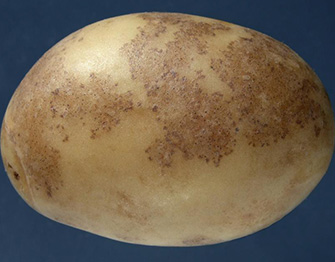Potato Black Dot Disease: Understanding the Elusive Pathogen, Disease Development, and Effective Management Strategies
Potato black dot disease, caused by the pathogen Colletotrichum coccodes, poses a significant threat to potato crops worldwide. This elusive pathogen primarily affects the tubers and can be spread through soil and plant debris. The disease development is influenced by various factors, including environmental conditions and host susceptibility. Accurate identification and diagnosis of the disease are crucial for implementing effective management strategies. In this article, we will explore the insights provided by the study conducted by Johnson et al. (2018) on potato black dot disease, along with potential future research directions and management approaches.
Understanding Potato Black Dot Disease:
Potato black dot disease is characterized by the presence of dark, sunken lesions on the tubers. These lesions are caused by the colonization of the pathogenic fungus, Colletotrichum coccodes. The disease can lead to significant yield losses and reduced tuber quality. Early detection and proper management are essential to minimize the impact of this disease on potato crops.
Identification and Diagnosis:
Accurate identification and diagnosis are vital for effective management of potato black dot disease. Visual inspection of tubers for characteristic symptoms, such as black dots or lesions, can provide preliminary indications of the disease. However, laboratory tests, including isolation and identification of the pathogen, are necessary to confirm the presence of Colletotrichum coccodes. Molecular techniques, such as polymerase chain reaction (PCR), can also be employed for precise identification.
Disease Development Factors:
Several factors contribute to the development and severity of potato black dot disease. Environmental conditions, such as temperature and humidity, play a crucial role in disease progression. The pathogen thrives in cool and wet conditions, making it more prevalent during certain seasons. Additionally, host susceptibility influences the severity of the disease. Some potato cultivars may exhibit higher resistance to the pathogen, while others are more susceptible.
Management Strategies:
Effective management of potato black dot disease requires a comprehensive approach that combines cultural, chemical, and biological control strategies.
- Cultural Control:
- Crop rotation: Avoid planting potatoes in the same field consecutively to reduce the buildup of the pathogen.
- Sanitation: Remove and destroy infected plant debris and tubers to prevent the spread of the disease.
- Soil management: Ensure proper drainage and avoid excessive soil moisture, as wet conditions favor disease development.
- Chemical Control:
- Fungicide application: In severe cases, fungicides can be used to suppress the pathogen. Consult local agricultural extension services for recommended fungicides and application rates.
- Biological Control:
- Biocontrol agents: Explore the use of beneficial microorganisms, such as Trichoderma spp., to suppress the growth and spread of Colletotrichum coccodes. Research in this area is still ongoing, but promising results have been reported.
Future Research and Conclusion:
The study by Johnson et al. (2018) provides valuable insights into the identification and management of potato black dot disease. However, there are still several areas that require further research. Future studies should focus on developing resistant potato cultivars through breeding programs and exploring alternative control methods, such as the use of biocontrol agents. Additionally, understanding the genetic basis of host resistance and the pathogen’s mode of action will contribute to the development of more targeted management strategies.
By implementing effective management strategies, farmers can protect their potato crops from the impact of this elusive pathogen. Early detection, proper identification, and a combination of cultural, chemical, and biological control measures are essential for minimizing the spread and severity of potato black dot disease. Through ongoing research and collaboration, we can continue to improve our understanding of this disease and develop sustainable solutions for its management.
By utilizing effective management tactics, farmers can safeguard their potato crops from the effects of this evasive pathogen. Timely detection, precise identification, and a combination of cultural, chemical, and biological control methods are essential for reducing the spread and intensity of potato black dot disease. With continual research and cooperation, we can maintain our knowledge of this disease and create viable solutions for its management.


